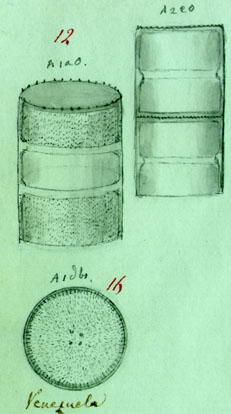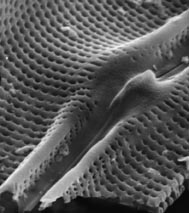| |
INTRODUCTION TO THE CAS DIATOM COLLECTION
 HOLDINGS HOLDINGS
At present,
the CAS Diatom Collection has original sample material from over 18,000
locality records, 59,000 microscope slides, 55,000 taxa identified on
slides, 8,400 diatom bibliographic references, and a database of 44,000
diatom species. The collection also houses important type material, with
a total of 15 generitypes, and holotypes and isotypes for over 470 taxa,
covering 128 genera (Kociolek et al. 1996). The locality, publication,
and taxon database is available for searching the CAS holdings.
ORIGIN OF THE COLLECTION
Dr. G Dallas
Hanna established the Diatom Collection at the California Academy of Sciences
in 1919. During his 51 year tenure in the Department of Paleontology,
Hanna collected many fossil localities in western North America. These
collections, which formed the backbone of the Academy’s diatom holdings,
served as the material for his research program on the taxonomy and biostratigraphy
of marine diatoms. With the publication of his many research articles,
Hanna became the acknowledged leader and pioneer in applying diatom biostratigraphy
to practical problems, including oil exploration. In addition to his own
collections he received many diatom-bearing samples from prospective oil-drilling
sites and well core samples, all of which included well-documented stratigraphic
information. The notoriety Hanna achieved led to extensive correspondence
with U.S. and foreign workers. Diatom materials were sent to Hanna from
all over the world for his review, insight and interpretation. As a result,
Hanna generated about 1200 samples and 9000 slides for the collection.
A.L. BRIGGER
"Doc"
Hanna’s interest and expertise in marine fossil diatom taxonomy and
systematics inspired several collaborative efforts, including one with
Albert Leon Brigger of Yucaipa, California. Brigger amassed a personal
collection from correspondence with practicing diatomists (Reinhold, Kanaya,
Lohman) and interested amateurs (Burke) as well as through purchases of
collections, including the collection of W.F. Herzberg. In all, the Brigger
Collection consisted of over 1900 samples and nearly 26,800 slides almost
all of which were single mounts. An especially significant part of the
Brigger Collection is the nearly 12,750 slides of the genus Aulacodiscus.
The major portion of the Brigger Collection arrived at CAS in 1977.
H.E. SOVEREIGN
The H.E.
Sovereign Collection consists of 1081 slides from nearly 550 localities.
Over 90% of the Sovereign Collection are from recent freshwater localities
in Washington and Oregon, collected between 1924 and 1962. The Sovereign
Collection includes 97 slides from the eminent German diatomist Fredrich
Hustedt. Mahood (1978) detailed the Sovereign collection holdings.
 OTHER
MAJOR COLLECTIONS OTHER
MAJOR COLLECTIONS
Several other
collections are part of the CAS holdings. The William Abbott Collection,
comprising over 2300 samples and 4000 slides from well-documented marine
fossil localities and geological sections. The Sam L. Van Landingham Collection,
with 2154 slides made from nearly 1420 samples, is derived from recent
and fossil freshwater collections. The W.I. Firth Collection of approximately
500 slides includes 89 slides of original William Smith material prepared
by Sturt. The Forest Begres Collection of central U.S. freshwater habitats
is a recent addition to the Academy holdings. The V. Porguen Collection
contains approximately 650 samples from marine fossils deposits.
RECENT ACQUISITIONS
Several significant
collections have recently arrived at the CAS Diatom Collection. The collections
currently being accessioned into the Hanna Database include: the collections
of G.W. Prescott, Wm.C. Vinyard, S.L. VanLandingham, S.R. Rushforth, J.P.
Bradbury, and the US Geological Survey National Water Quality Assessment
Program (NAQWA).
|
|